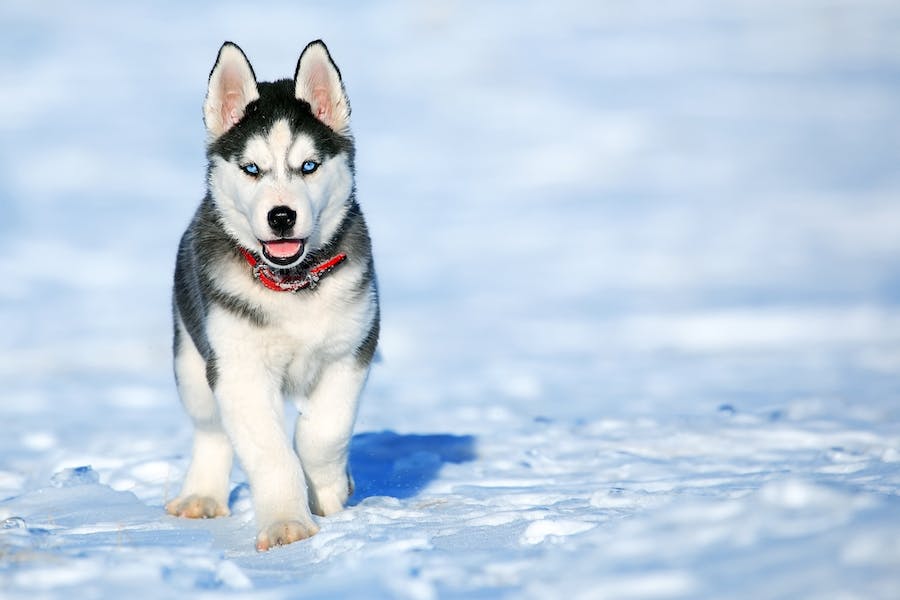Siberian Huskies, known for their endurance and agility, can reach speeds up to 28-30 miles per hour (45-48 km/h) in short bursts. This speed is a testament to their heritage as sled dogs, where stamina combined with bursts of speed is crucial. However, it’s important to note that Huskies are more renowned for their endurance than their top speed. They can maintain a steady pace of about 10-12 miles per hour (16-19 km/h) over long distances, making them exceptional long-distance runners rather than sprinters. Their remarkable endurance is what has made them famous in sled dog racing and Arctic expeditions.
How Fast Can a husky run?
Siberian Huskies, known for their endurance and agility, can reach speeds up to 28-30 miles per hour (45-48 km/h) in short bursts. This speed is a testament to their heritage as sled dogs, where stamina combined with bursts of speed is crucial. However, it’s important to note that Huskies are more renowned for their endurance than their top speed. They can maintain a steady pace of about 10-12 miles per hour (16-19 km/h) over long distances, making them exceptional long-distance runners rather than sprinters. Their remarkable endurance is what has made them famous in sled dog racing and Arctic expeditions.
Historical Background Of The Siberian Husky
The Siberian Husky boasts a rich and intriguing historical background, deeply rooted in the harsh environments of Northeast Asia. Their story is one of survival, utility, and companionship:
The Chukchi people, an indigenous tribe in Siberia, over thousands of years, developed the Husky’s ancestors. These dogs were bred primarily for their ability to pull light loads over vast, frozen landscapes at moderate speeds, showcasing their endurance and resilience in extreme cold conditions.
For the Chukchi, the Siberian Husky was more than just a sled dog; they were vital for survival. They provided transportation across the vast and treacherous Siberian landscape, crucial for hunting and moving between camps. Huskies also helped to keep children warm during the brutal Siberian nights.
The breed was introduced to Alaska during the gold rush in the early 20th century. Imported for sled dog racing, they quickly gained fame for their incredible endurance and speed in long-distance sled racing.
The 1925 Nome Serum Run in Alaska was a pivotal moment in Husky history. A team of Huskies, led by the famous Balto and Togo, delivered diphtheria antitoxin over 674 miles in harsh winter conditions, saving the town of Nome from an epidemic. This event significantly increased their popularity in the United States.
The American Kennel Club (AKC) recognized the Siberian Husky in 1930. The breed standard was developed, emphasizing their medium size, moderate bone, well-furred body, erect ears, and brush tail.
During World War II, Siberian Huskies served in the United States Army’s Arctic Search and Rescue Unit. Their skills in navigating snowy terrains were invaluable in rescue missions.
What Physical Attributes Contribute To The Speed Of A Siberian Husky?
The speed of a Siberian Husky is a product of several fundamental physical attributes inherent to the breed. These features, honed by their historical background and breeding, contribute significantly to their agility and endurance:
Muscular Build: Huskies possess a well-proportioned, muscular body. Their lean muscle mass, especially in the hindquarters, provides the power necessary for rapid acceleration and maintaining high speeds.
Double Coat: Their unique double coat, comprising a dense undercoat and a longer topcoat, is not just for insulation against cold weather. It also offers protection against overheating, allowing them to maintain physical exertion for longer periods without overheating, which is crucial for speed and endurance.
Paw Structure: The Husky’s paws are another vital attribute. They are compact and furry, acting like natural snowshoes, providing traction and insulation. This helps them to maintain speed on snowy or slippery terrain.
Aerodynamic Body Shape: The body shape of a Husky is streamlined, minimizing air resistance when they run. This aerodynamic design helps them to move swiftly and efficiently.
Flexible Spine: Huskies have a flexible spine contributing to their distinctive gait, known as a double suspension gallop. This gait allows them to cover more ground while expending less energy, which is ideal for maintaining high speeds.
Efficient Respiratory and Cardiovascular System: Their respiratory and cardiovascular systems are highly efficient, allowing for better oxygenation and endurance. This efficiency is crucial for maintaining speed over long distances.
Tail for Balance: The bushy tail of a Husky not only protects their face from the cold but also aids in balance while running at high speeds, allowing for more agile and swift movements.
Factors Affecting A Husky’s Speed
Several factors can significantly influence the speed of a Siberian Husky. Understanding these elements is crucial for anyone looking to optimize the physical performance of these dogs, whether for racing, working, or ensuring a healthy lifestyle:
Age and Health:
Like all animals, a Husky’s age and overall health are critical in speed. Younger dogs are generally faster and have more stamina. Conversely, as Huskies age, their speed and endurance may decrease. Health issues like joint problems or respiratory conditions can also limit their running ability.
Training and Conditioning:
Proper training and regular exercise are essential for maintaining a Husky’s speed. A well-conditioned Husky, regularly trained for endurance and strength, will naturally be faster and more agile. Lack of exercise or improper training can lead to decreased performance.
Diet and Nutrition:
A balanced diet rich in nutrients is vital for a Husky’s energy and muscle health. Proper nutrition can enhance a dog’s physical capabilities, while a poor diet can lead to weight gain and reduced stamina, subsequently affecting speed.
Weather and Climate Conditions:
Huskies are bred for cold climates and can overheat in warmer temperatures, significantly slowing them down. They are most comfortable and perform best in more excellent conditions. High humidity or extreme heat can hinder their ability to run at total capacity.
Terrain:
The type of terrain can also affect a Husky’s speed. They are best suited to snowy or soft terrains, where they can utilize their paw structure for maximum traction. Rough or slippery surfaces might slow them down due to reduced traction or increased risk of injury.
Mental State and Motivation:
A Husky’s mental state and level of motivation can impact its desire to run and its speed. Dogs that are mentally stimulated and motivated, whether by their environment or by encouragement from their owner, tend to perform better.
Genetics:
A Husky’s genetic makeup can also be a factor. Some Huskies are explicitly bred for speed and endurance, inheriting traits from a lineage of racing or working dogs. Others might be bred more for companionship and may not possess the same physical attributes conducive to high speed.
Physical Load:
A Husky’s weight, whether pulling a sled or carrying a backpack during hikes, will affect its speed. Heavier loads will naturally slow a dog down and can affect their endurance over time.
How Do You Care For A Husky To Maintain Optimal Speed?
Caring for a Siberian Husky to maintain its optimal speed involves a holistic approach encompassing diet, exercise, health management, and mental well-being. Here are key strategies to ensure your Husky stays in top shape:
- Balanced Diet: Provide a high-quality diet that meets their energy needs. Huskies are active dogs and may require food rich in protein and fat to sustain their energy levels. Ensure the diet is appropriate for their age, size, and activity level. Avoid overfeeding to prevent obesity, which can significantly slow down a dog.
- Regular Exercise: Huskies need ample exercise to maintain their physical condition. This should include endurance exercises, like long walks or jogs, and short bursts of high-intensity activities, like sprinting or playing fetch. Ensure that they get exercise daily to maintain muscle tone and cardiovascular health.
- Proper Hydration: Always provide access to fresh water, especially after exercise. Proper hydration is crucial for maintaining their health and energy levels.
- Climate Considerations: Since Huskies are bred for cold climates, managing their exercise routine in warmer weather is crucial to prevent overheating. Schedule exercise during more excellent parts of the day and provide a cool, shaded area for them to rest.
- Health Check-ups: Regular veterinary check-ups are important to ensure your Husky is healthy. This includes vaccinations, parasite control, and screenings for common health issues in the breed, such as hip dysplasia or eye problems.
- Mental Stimulation: Huskies are intelligent and require mental stimulation to prevent boredom, which can affect their overall well-being. Engage them with interactive toys, training sessions, and activities that challenge their mind.
- Training and Socialization: Proper training and socialization from a young age can contribute to their mental health and behavior. A well-trained Husky is more likely to respond to exercise routines and perform better.
- Grooming: Regular grooming is essential to keep their coat in good condition. This includes brushing to remove dead fur, especially during shedding seasons, and bathing as needed. A healthy coat contributes to better temperature regulation.
Conclusion
The Siberian Husky is a remarkable breed renowned for its speed and endurance. Their unique physical attributes, rich history, and adaptability make them exceptional both as working dogs and companions. To maintain their optimal speed and health, providing them with a balanced diet, regular exercise, proper health care, and mental stimulation is crucial. Understanding and catering to their needs, especially considering their breed-specific characteristics, ensures that these majestic dogs can lead a fulfilling and active life. The care and commitment invested in a Husky enhance their physical capabilities and strengthen the bond between the dog and its owner, making caring for a Husky a gratifying experience.
FAQ’s
Q. What is the average speed of a husky?
A. The average speed of a Siberian Husky typically ranges between 10 to 12 miles per hour (16 to 19 kilometers per hour). However, Huskies are known for their endurance rather than top speed and can maintain this pace over long distances. It’s important to note that individual Huskies may vary, and factors like age, health, and training can influence their speed.
Q. Is a Husky, a powerful dog?
A. Yes, a Siberian Husky is considered a powerful dog. They are known for their strength, endurance, and impressive pulling capacity. Huskies were originally bred as sled dogs, and their muscular build and determination make them well-suited for pulling heavy loads over long distances. Their power and stamina are among the key traits that have made them valuable working dogs and sled racing champions.
Q. How long can Husky live?
A. On average, Siberian Huskies have a lifespan of 12 to 15 years. However, some Huskies have been known to live even longer with proper care, a healthy diet, regular exercise, and regular veterinary check-ups. Providing them with a loving and well-maintained environment is important to ensure a longer and healthier life.







Leave a Reply